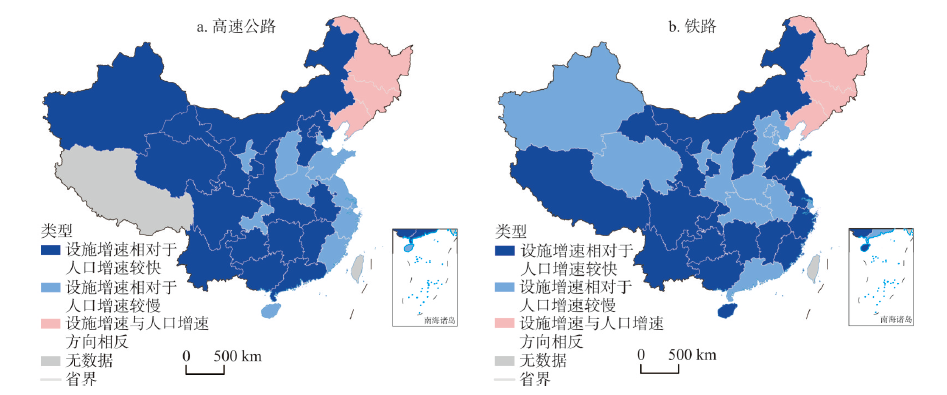

Population-development oriented comprehensive modern transport system in China
Received date: 2020-03-30
Request revised date: 2020-11-30
Online published: 2021-02-25
Supported by
National Natural Science Foundation of China(41925003)
The National Development and Reform Commission Key Research Project for the National 14th Five Year Plan(20181201)
Copyright
China's modernized transport strategies have been focused on building new infrastructures in areas with insufficient transport facilities, supplying the lack of new transport services, and investing in transport construction on a large scale since the 10th Five-Year Plan (2000-2005). However, these strategies are now facing new situations in population development, including population growth, migration, spatial relocation and agglomeration, and changes in lifestyle. It is imperative to investigate population-development oriented comprehensive modern transport system in order to implement people-oriented principles and the National Strategy of Strengthening Country in Transportation. This study presents some research results from the National Development and Reform Commission Key Research Project for the National 14th Five-Year Plan (2021-2025), "Population Development and Modern Transportation System Strategies in China". The study is based on theoretical mechanisms in the coupling and interaction between population and transport system. It conducts in-depth analyses on the new trends of population development and transport demand, and proposes a new "diamond" strategy for China's comprehensive transport system in order to cope with these new trends. According to this strategy, the new comprehensive modern transport system in China will have four "diamond pole" including Beijing-Tianjin-Hebei region, Yangtze River Delta, Guangdong-Hong Kong-Macao Greater Bay Area, and Chengdu-Chongqing region, four "diamond edges" including Beijing-Shanghai (Jing-Hu), Shanghai-Guangdong (Hu-Yue), Guangdong-Sichuan (Yue-Chuan), and Beijing-Sichuan (Jing-Chuan) transport corridors, two cross backbones including water transport along the Yangtze River and Beijing-Hong Kong-Macao transport corridors, and multiple transport hubs in cities with intensive intracity population movement flow. The study also proposes key missions to implement the new strategy in order to build population-development oriented comprehensive modern transport system in China, which includes supporting the national development and spatial plan, applying for the National Strategy of Strengthening Country in Transportation, and supplying high-quality transport services with a priority to the people.

ZHAO Pengjun , LYU Di , HU Haoyu , CAO Yushu , XIE Jinxin , PANG Liang , ZENG Liang'en , ZHANG Tingyu , YUAN Dandan . Population-development oriented comprehensive modern transport system in China[J]. Acta Geographica Sinica, 2020 , 75(12) : 2699 -2715 . DOI: 10.11821/dlxb202012011
图16 国家综合交通体系“钻石战略”布局注:基于自然资源部标准地图服务网站审图号为GS(2016)1569号的标准地图制作,底图无修改。 Fig. 16 The layout of national integrated transportation system "diamond strategy" of China |
表1 “钻石网络”骨干通道现状Tab. 1 Main transport corridors in the "diamond network" |
| 通道 | 连通地区 | 通道 | 子通道 | 途径重要节点 | 高速公路及高速铁路建设现状 |
|---|---|---|---|---|---|
| 菱形骨架 | 京津冀—长三角 | 京沪通道 | 京沪线通道 | 北京、济南、南京、上海 | 已建成高速公路、全线已建成350 km/h铁路 |
| 北部沿海海岸通道 | 北京、青岛、上海 | 已建成高速公路、烟台—盐城已建成200~250 km/h铁路 | |||
| 长三角—粤港澳 | 沪粤通道 | 沪杭广通道 | 上海、杭州、广州 | 已建成高速公路、上海—金华已建成350 km/h铁路 | |
| 东南沿海海岸通道 | 上海、宁波、福州、厦门、深圳 | 已建成高速公路、全线已建成200~250 km/h铁路 | |||
| 京津冀— 成渝 | 京川通道 | 京太西成通道 | 北京、太原、西安、成都 | 已建成高速公路、全线已建成200~250 km/h铁路 | |
| 京郑西渝通道 | 北京、郑州、西安、重庆 | 已建成高速公路、北京—西安已建成350 km/h铁路 | |||
| 粤港澳— 成渝 | 粤川通道 | 成贵南广通道 | 成都、贵阳、南宁、广州 | 已建成高速公路、南宁—广州已建成200~250 km/h铁路 | |
| 渝贵桂广通道 | 重庆、贵阳、桂林、广州 | 已建成高速公路、贵阳—广州已建成300 km/h铁路 | |||
| 十字骨架 | 京津冀—粤港澳 | 京港澳 通道 | 京广线通道 | 北京、郑州、武汉、长沙、广州 | 已建成高速公路、全线已建成350 km/h铁路 |
| 京九线通道 | 北京、雄安新区、合肥、南昌、深圳 | 已建成高速公路、合肥—福州已建成350 km/h铁路 | |||
| 长三角— 成渝 | 长江水陆通道 | 长江北通道 | 上海、南京、合肥、武汉、重庆、成都 | 已建成高速公路、全线已建成200~250 km/h铁路 | |
| 长江南通道 | 上海、杭州、南昌、长沙、重庆、成都 | 已建成高速公路、上海—长沙已建成350 km/h铁路 |
| [1] |
[ 张学良. 交通基础设施、空间溢出与区域经济增长. 南京: 南京大学出版社, 2009: 128-131.]
|
| [2] |
|
| [3] |
|
| [4] |
[ 李宏. 对我国综合交通体系发展的思考. 综合运输, 2005(3):6-10.]
|
| [5] |
[ 欧国立. 基于三维层面的综合交通运输认识论. 综合运输, 2008(7):4-8.]
|
| [6] |
[ 罗仁坚. 综合运输体系的内涵和发展理念. 综合运输, 2009(4):4-7.]
|
| [7] |
[ 荣朝和. 关于综合交通运输的重新认识. 综合运输, 2011(12):4-9.]
|
| [8] |
[ 金凤君, 王姣娥. 20世纪中国铁路网扩展及其空间通达性. 地理学报, 2004,59(2):293-302.]
|
| [9] |
[ 吴传钧. 论地理学的研究核心: 人地关系地域系统. 经济地理, 1991,11(3):1-6.]
|
| [10] |
[ 杨吾扬, 杨齐. 论城市的地域结构. 地理研究, 1986,5(1):1-11.]
|
| [11] |
|
| [12] |
|
| [13] |
|
| [14] |
|
| [15] |
|
| [16] |
|
| [17] |
|
| [18] |
|
| [19] |
|
| [20] |
|
| [21] |
|
| [22] |
|
| [23] |
|
| [24] |
|
| [25] |
|
| [26] |
|
| [27] |
|
| [28] |
|
| [29] |
|
| [30] |
|
| [31] |
|
| [32] |
[ 金凤君, 陈卓. 1978年改革开放以来中国交通地理格局演变与规律. 地理学报, 2019,74(10):1941-1961.]
|
| [33] |
[ 王亿方, 刘翀, 谢辉. 虹桥综合交通枢纽十年发展回顾与展望. 城市交通, 2019(5):59-65.]
|
| [34] |
Party Group of the Ministry of Transport of the Communist Party of China. Comprehensively deepen reform and opening up and strive to move from a big transportation country to a powerful transportation country. Journal of the Ministry of Transport and Management, 2018,28(4):3-5.
[ 中共交通运输部党组. 全面深化改革开放奋力从交通大国迈向交通强国. 交通运输部管理干部学院学报, 2018,28(4):3-5.]
|
| [35] |
Aurora Big Data. 2018 China Urban Commuter Research Report. https://www.jiguang.cn/reports/305, 2018-06-15/2020-05-14.
[ 极光大数据. 2018年中国城市通勤研究报告. https://www.jiguang.cn/reports/305, 2018-06-15/2020-05-14.]
|
/
| 〈 |
|
〉 |